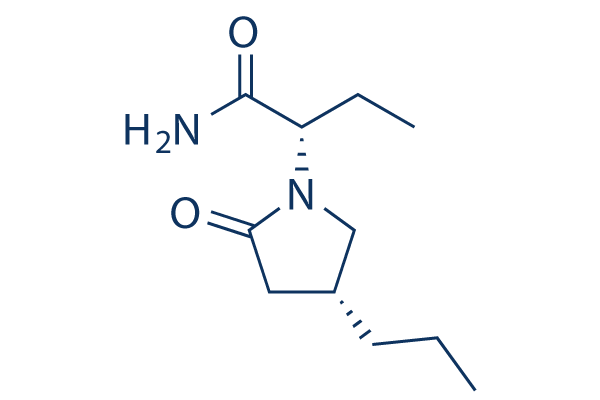All AbMole products are for research use only, cannot be used for human consumption.

In vitro: Brivaracetam in vitro exerts a dose-dependent cytotoxic effect on various glioma cell lines and this effect is concomitant with the modulation of a number of miRNAs.
In vivo: Brivaracetam reduces spike-wave discharges in Alzheimer's disease mice and reverses impairments in spatial memory in APP/PS1 mice. Human pharmacology studies have shown that brivaracetam has a half-life of approximately 8 h and does not vary with the administered dose. It has nearly complete bioavailability. Plasma protein binding is weak (20%), the volume of distribution, 0.6 l/kg, being close to that of total body water. Brivaracetam is primarily metabolized via hydrolysis of the acetamide group and CYP2C8-mediated hydroxylation. Its metabolites are not pharmacologically active. Brivaracetam is neither mutagenic nor clastogenic. Single oral doses of brivaracetam, up to 1000 mg and repeated oral doses up to 800 mg/d b.i.d., are well-tolerated in healthy volunteers and in patients. Treatment-emergent adverse events are mostly CNS-related and transient, and their intensity is usually mild or moderate. Repeated intake of the drug reduces their incidence.
| Cell Experiment | |
|---|---|
| Cell lines | U87MG cell line, SW1783 and T98G cells |
| Preparation method | Cytotoxicity of BRV was studied by cell proliferation assay. |
| Concentrations | 0-2500 μM |
| Incubation time | 0-24-48-72 h |
| Animal Experiment | |
|---|---|
| Animal models | Transgenic Alzheimer’s disease (AD) mice |
| Formulation | normal saline |
| Dosages | 10 mg/kg |
| Administration | i.p. |
| Molecular Weight | 212.29 |
| Formula | C11H20N2O2 |
| CAS Number | 357336-20-0 |
| Solubility (25°C) | 10 mM in DMSO |
| Storage |
Powder -20°C 3 years ; 4°C 2 years In solvent -80°C 6 months ; -20°C 1 month |
[3] Philipp von Rosenstiel. Neurotherapeutics. Brivaracetam (UCB 34714)
| Related Sodium Channel Products |
|---|
| 5-(N,N-Hexamethylene)-amiloride
5-(N,N-Hexamethylene)-amiloride (Hexamethylene amiloride) is a potent Na+/H+ exchanger inhibitor, which decreases the intracellular pH (pHi) and induces apoptosis in leukemic cells. 5-(N,N-Hexamethylene)-amiloride (Hexamethylene amiloride) is also an inhibitor of the HIV-1 Vpu virus ion channel and inhibits mouse hepatitis virus (MHV) replication and human coronavirus 229E (HCoV229E) replication in cultured L929 cells with EC50s of 3.91 μM and 1.34 μM, respectively. |
| HwTx-IV
Huwentoxin-IV (HwTx-IV) is a 35-residue neurotoxin peptide with potential application as a novel analgesic. Huwentoxin-IV, a component of tarantula venom, potently blocks sodium channels and is an attractive scaffold for engineering a Nav1.7-selective molecule. |
| ST-2560
ST-2560 is a selective inhibitor of the NaV1.7 sodium channel with IC50 value of 39 nM in primates with ≥1000-fold selectivity over other isoforms of the human NaV1.x family. |
| A-317567
A-317567 is a potent acid-sensing ion channel 3 (ASIC-3) inhibitor with an IC50 of 1.025 μM. |
| XPC-6444
XPC-6444 is a highly potent, isoform-selective, and CNS-penetrant NaV1.6 inhibitor (IC50=41 nM for hNaV1.6). |
All AbMole products are for research use only, cannot be used for human consumption or veterinary use. We do not provide products or services to individuals. Please comply with the intended use and do not use AbMole products for any other purpose.


Products are for research use only. Not for human use. We do not sell to patients.
© Copyright 2010-2024 AbMole BioScience. All Rights Reserved.
